Guide to Aluminum Profiles for LED Strips
Table of Contents
LED strip lights are increasingly preferred due to their power-saving properties and versatility. Numerous methods are available for installing these lights, one prevalent choice being aluminum profiles. This article aims to elucidate the concept of aluminum profiles for LED strip lighting, touching on their advantages, varieties, and pointers for installation.

What does an LED aluminum profile entail?
LED aluminum profiles, also known as aluminum extrusions, are predominantly made of aluminum and are devised to encase and safeguard LED strip lights. They are crucial in facilitating rapid heat dissipation from the LED strip.
LED aluminum profiles are gaining momentum in commercial and residential spaces due to their numerous advantages. Notably, they enhance the lifespan of the LED strip. Moreover, they are more resilient than traditional lighting fixtures and can tolerate challenging conditions in several LED light usages areas, such as retail stores and eateries.
What are the prevalent LED aluminum profiles?
The ubiquity of LED aluminum profiles in new and existing buildings has become common. However, they come in different types. The most widespread ones include:
1. Surface-mounted LED aluminum profile
This is the most prevalent type, also known as a U-shaped LED channel. They are straightforward to install using mounting clips. You can affix them on many surfaces, such as under cabinets, ceilings, wardrobes, etc.
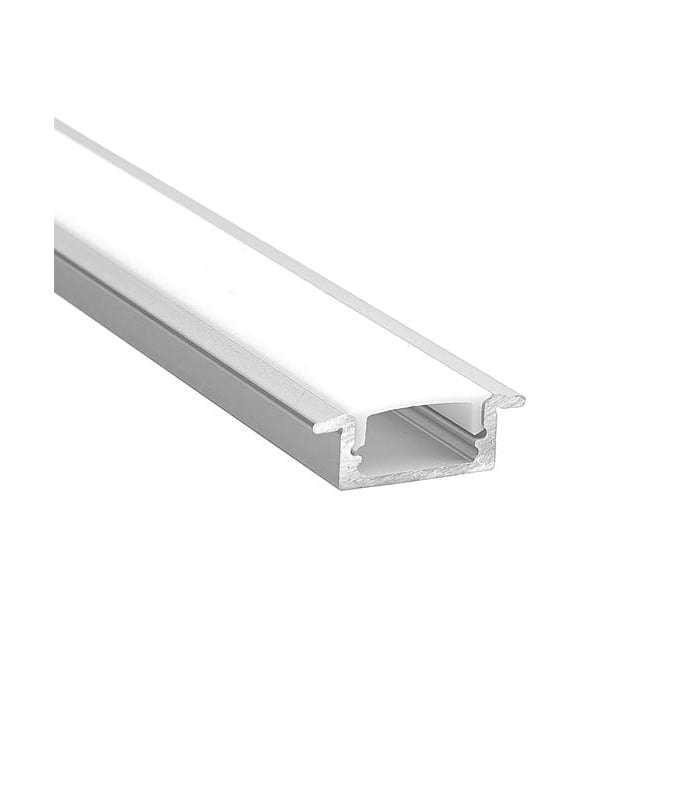
2. Recessed-mounted LED aluminum profile
Known as the T-shaped LED aluminum profile, these are embedded within the surface and commonly used on wooden shelves or cabinets. Installation requires carving out an appropriate slot matching the channel’s size.
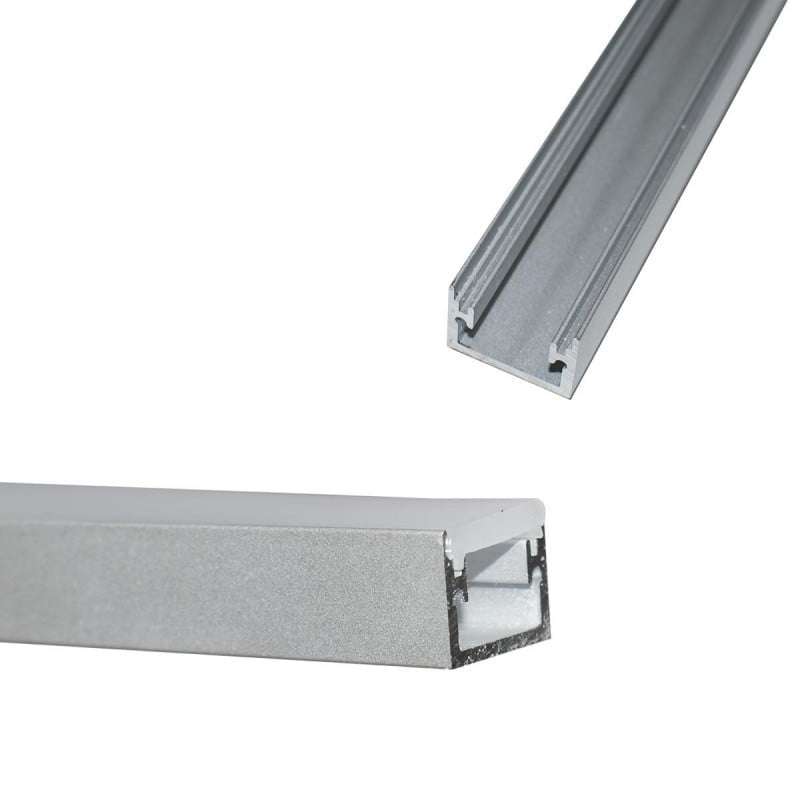
3. Corner LED aluminum profile
These profiles have an angled design, primarily used for installation on the corners of walls, ceilings, shelves, cabinets, and stairs. The installation process resembles surface-mounted LED aluminum profiles, utilizing mounting clips.
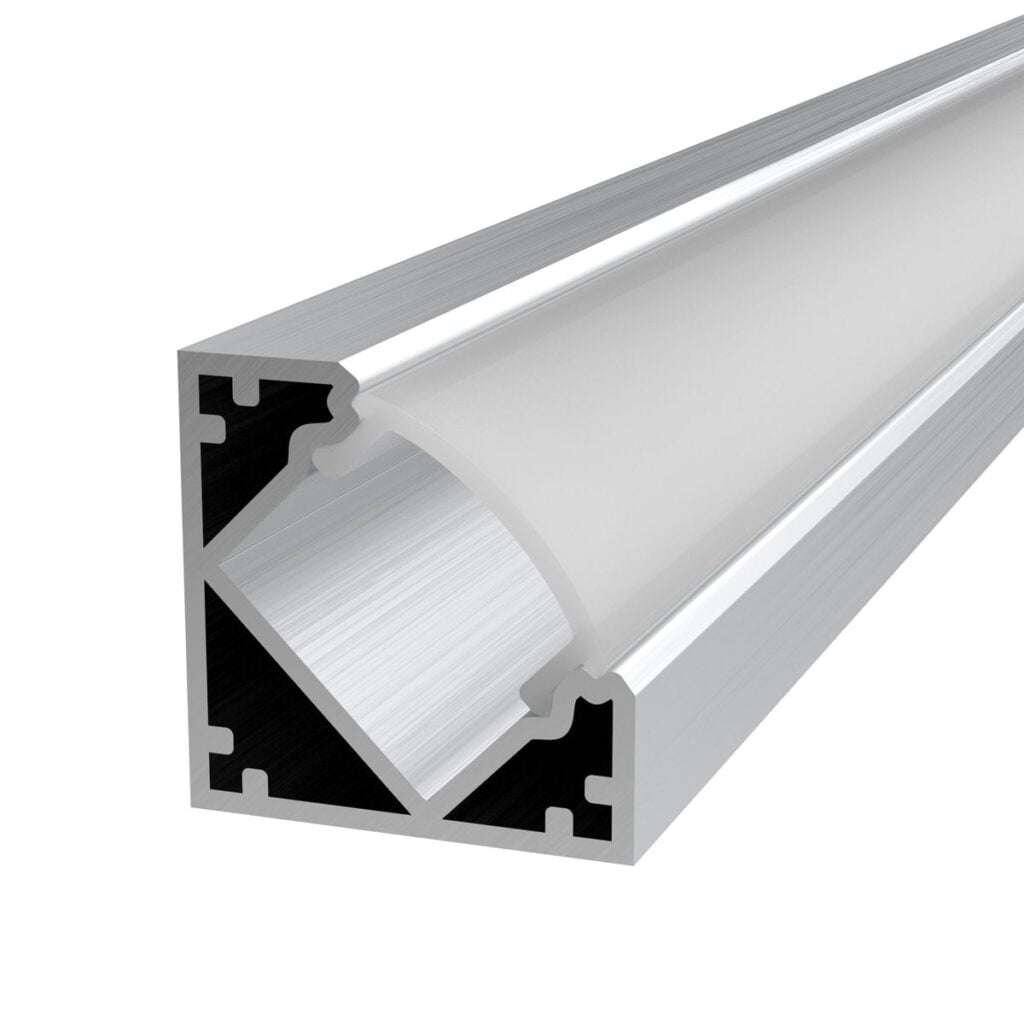
4. Drywall LED aluminum profile
This LED channel offers a streamlined effect and conceals all wires and LED strips on the wall. This installation might be complex and necessitate professional intervention and meticulous planning. It’s prevalent in shops, stores, and other commercial spaces with drywall ceilings.
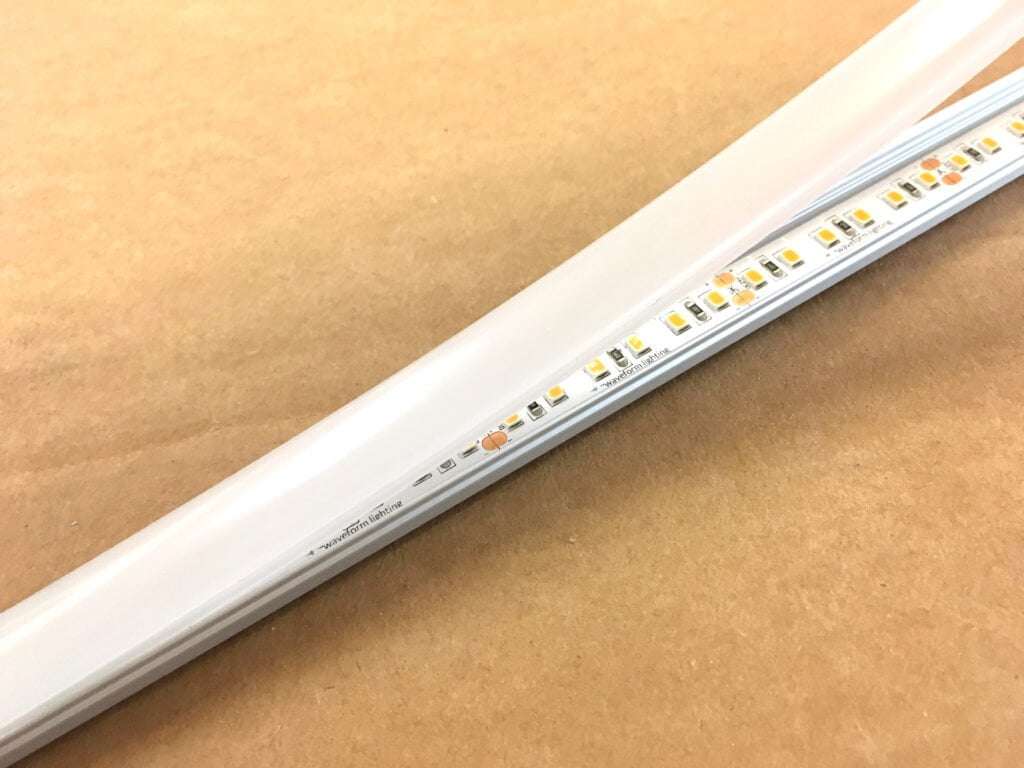
5. Suspended LED aluminum profile
Suspended from the ceiling using stainless steel ropes, these aluminum profiles are ideal for spaces with high ceilings. They are becoming more popular for their potential to form various attractive shapes.

6. Ring Circular LED aluminum profile
These extrusions, intended to be circular, are generally suspended from the ceiling. They are decorative, functional, and widely used in commercial and residential settings. They can be custom-made to various diameters, and lighting direction can be adjusted as desired.

7. Wardrobe rail LED aluminum profile
Employed in wardrobes, these provide lighting and serve as clothes hangers. They typically have an oval shape with a diffuser at the rod’s bottom.
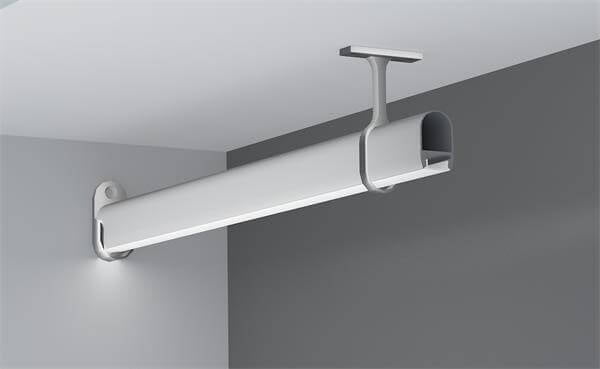
8. Floor LED aluminum profile
These profiles are waterproof and embedded into the floor, making them highly durable and step-resistant. They are both functional and decorative. For instance, ground LED channels can indicate emergency exits.
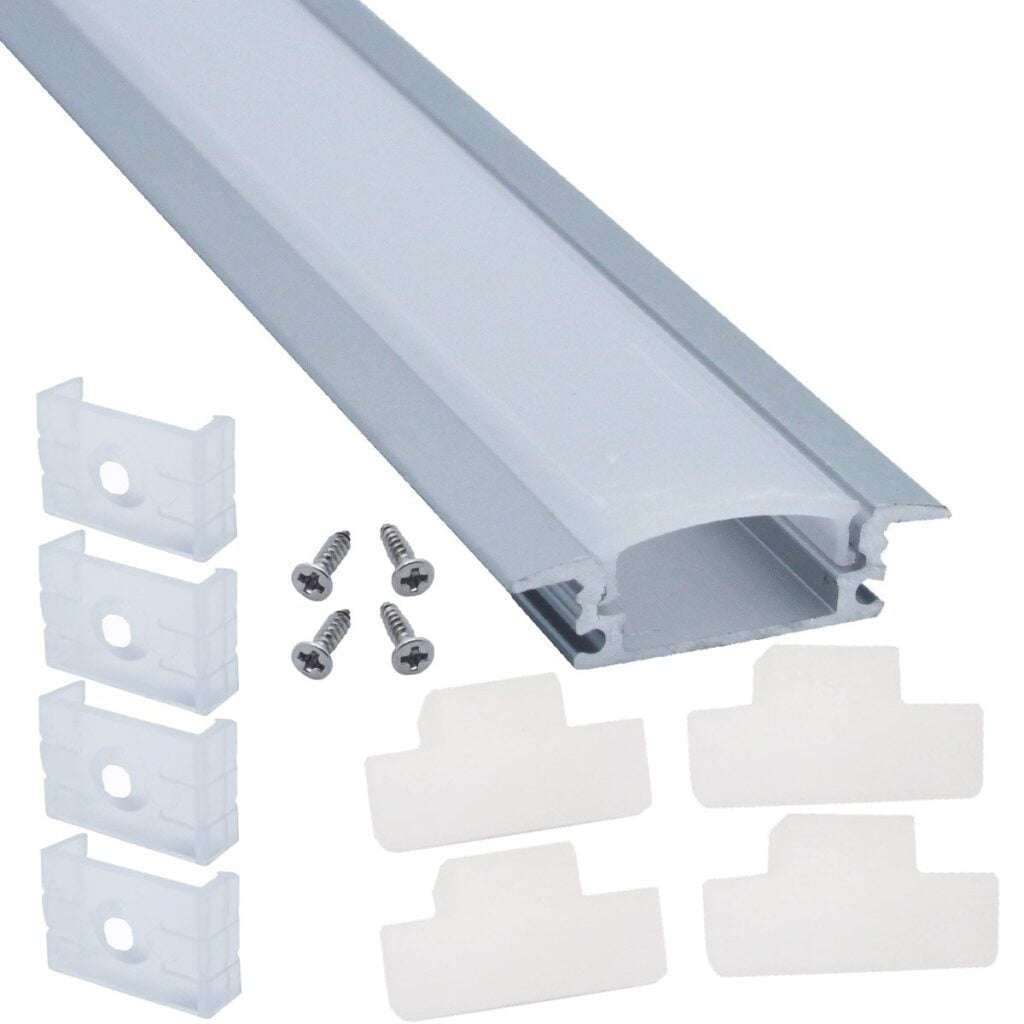
9. Wall LED aluminum profile
Installed on the wall for indirect lighting, they brighten up pathways, making it safer for people to move around without stumbling.
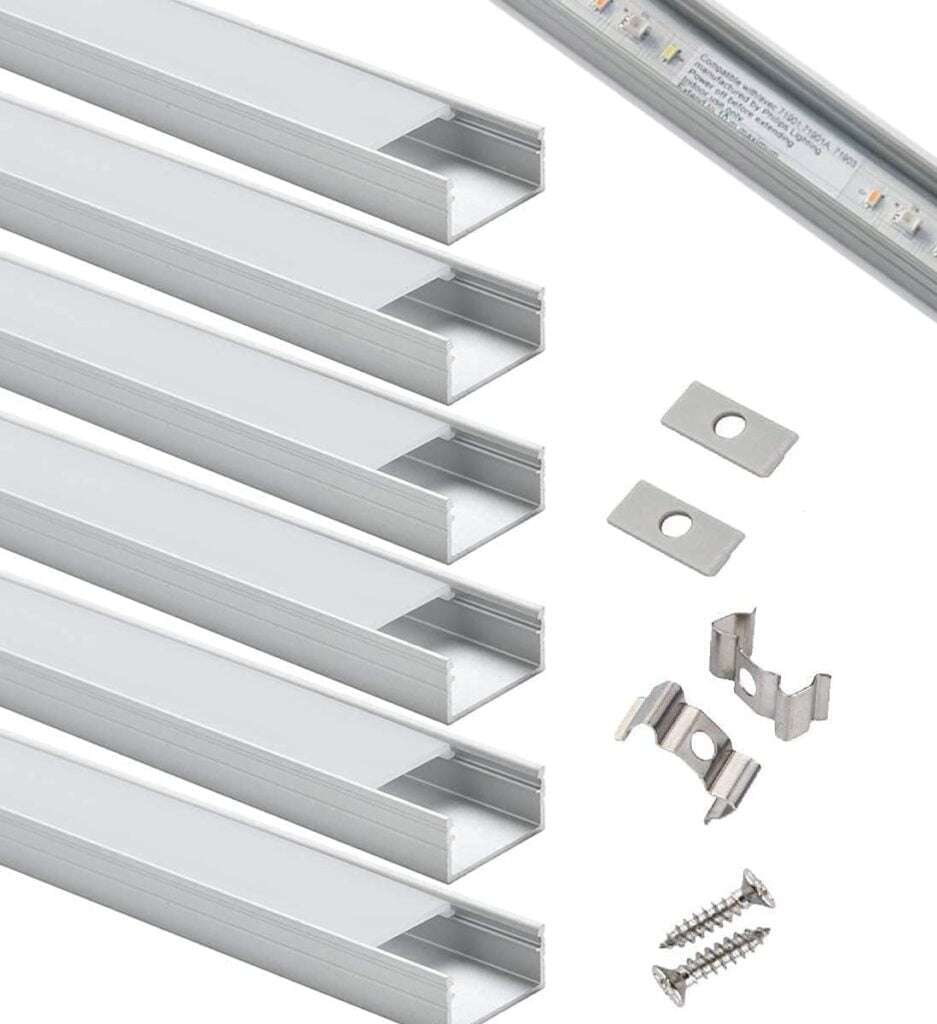
10. Stair LED aluminum profile
These LED extrusions are fitted on the stairs, facilitating movement in dimly lit environments. They are common in cinemas but also apply in commercial and home lighting.

11. Optic Lens LED aluminum profile
Distinct from other profiles, the diffuser of this LED aluminum profile is not flat. It can modify the lighting angle of the enclosed LED strip. These aluminum channels are helpful when a narrow beam angle is needed.
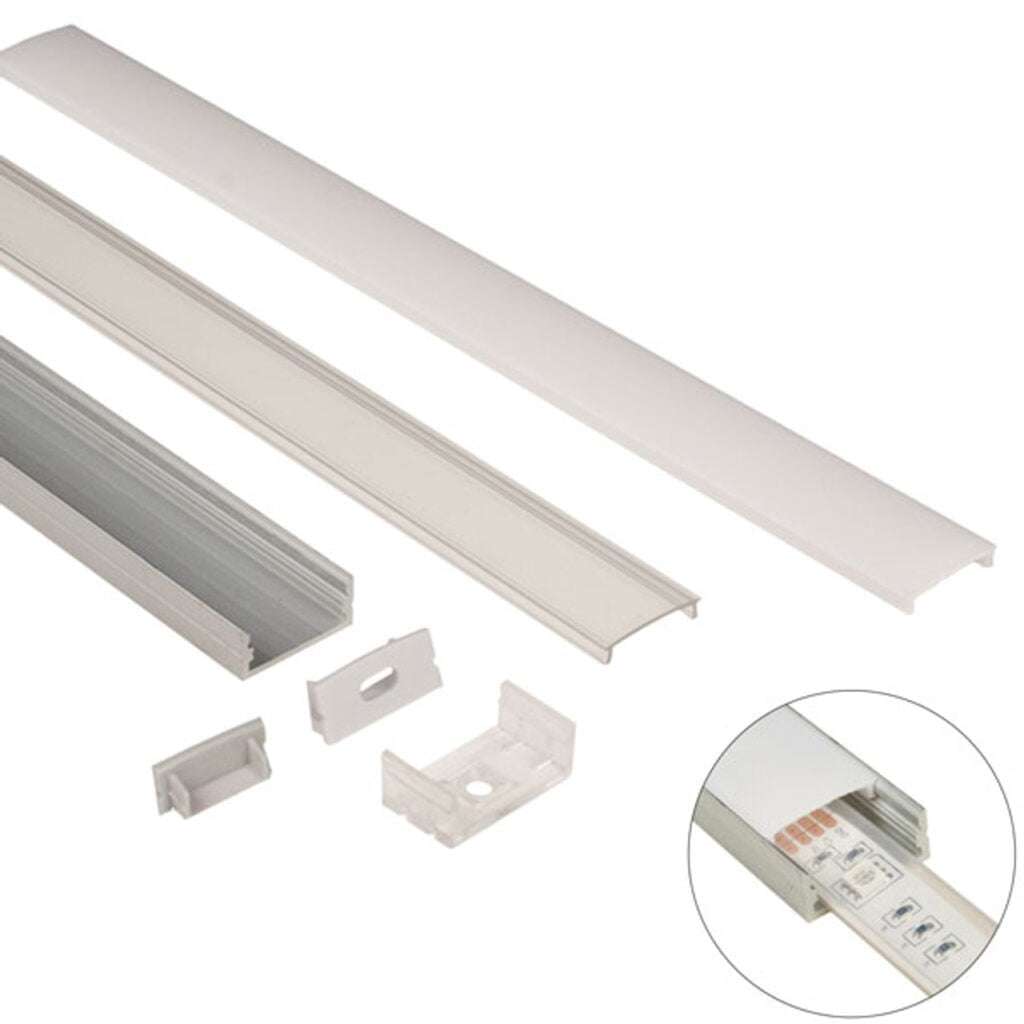
What kinds of diffusers can be used with LED aluminum profiles?
How can I determine the ideal one with such a wide range of diffusers?
Currently, the diffuser industry primarily utilizes two materials, namely PC and PMMA.
PC diffuser
| Pros | Cons |
| 1. Impact resistant. 2. Flame-retardant materials are not easy to burn. 3. Environmentally friendly plastics. 4. UV resistant. 5. Weather resistance (outdoor aging resistance). |
1. Low surface hardness. 2. Easy to scratch. |
PMMW diffuser
| Pros | Cons |
| 1. Good transparency. 2. The surface has good scratch resistance. |
1. Large wear coefficient. 2. Larger tendency of high-temperature thermal deformation. 3. Easy to crack. |
The light passage varies across different types of diffusers. Select a diffuser based on the desired lighting effect.
Transparent Diffuser
This diffuser allows 85-95% light passage, ideal for maximum brightness. However, it does not produce a spotless light effect.
Semi-Clear Diffuser
This diffuser is a middle-ground option with a spare transmission capacity of 70-80%.
Opal Diffuser
Like the semi-clear diffuser, it allows 70-80% light transmittance and helps reduce light spots and distribute light evenly.
Black Diffuser
With a low light transmittance of 30-35%, the black diffuser shares a similar decorative function as the opal diffuser, obscuring the LED strip. You may need a brighter LED strip to enhance brightness due to its lower transmittance rate.
What are the different finishes available for LED channels?
The majority of aluminum LED channels undergo an anodization process. Anodization is an electrochemical process that imparts a corrosion-resistant, durable, and decorative layer. Other finishes, such as powder coating, painting, and gloss dipping, are also utilized for protective and aesthetic reasons.
The standard anodized finishes for LED aluminum profiles include silver, white, and black.
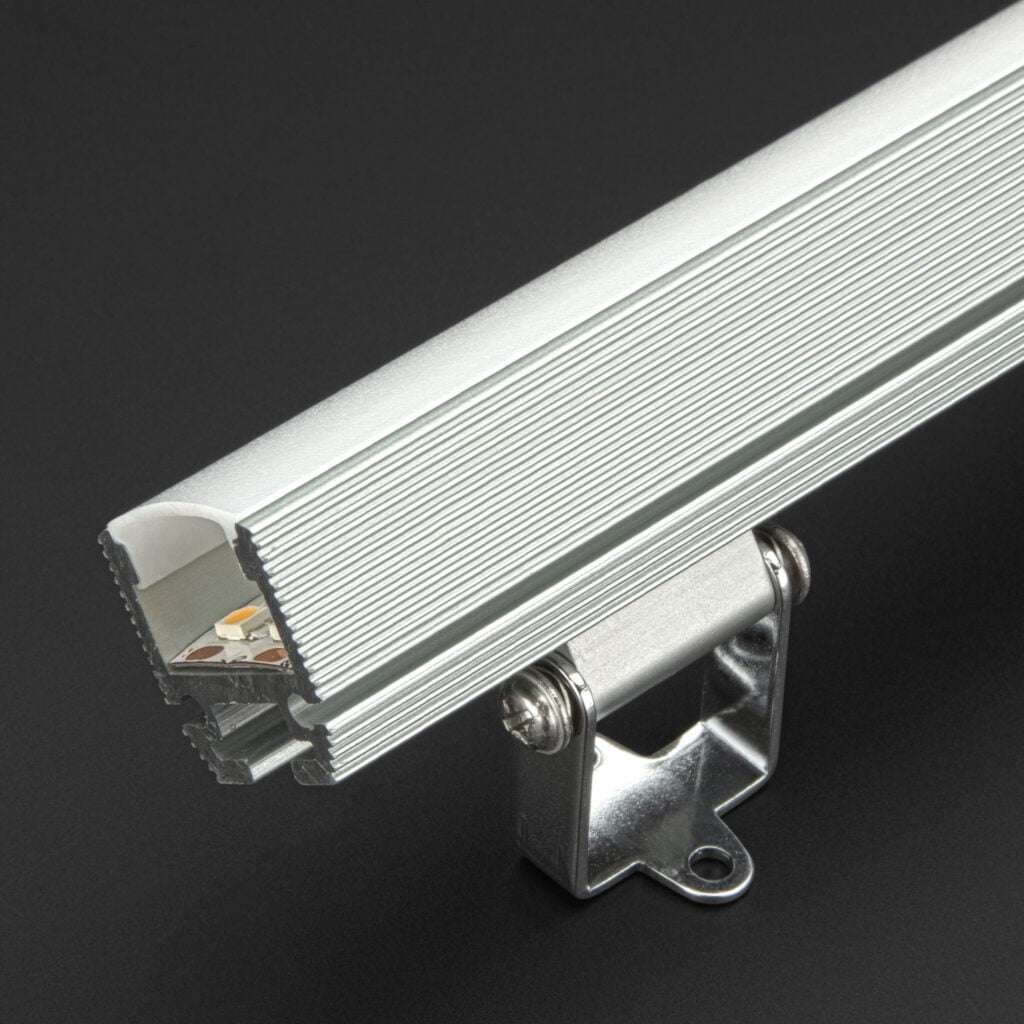
What components comprise an LED aluminum profile?
An LED aluminum profile is more than just aluminum – it includes these integral components:
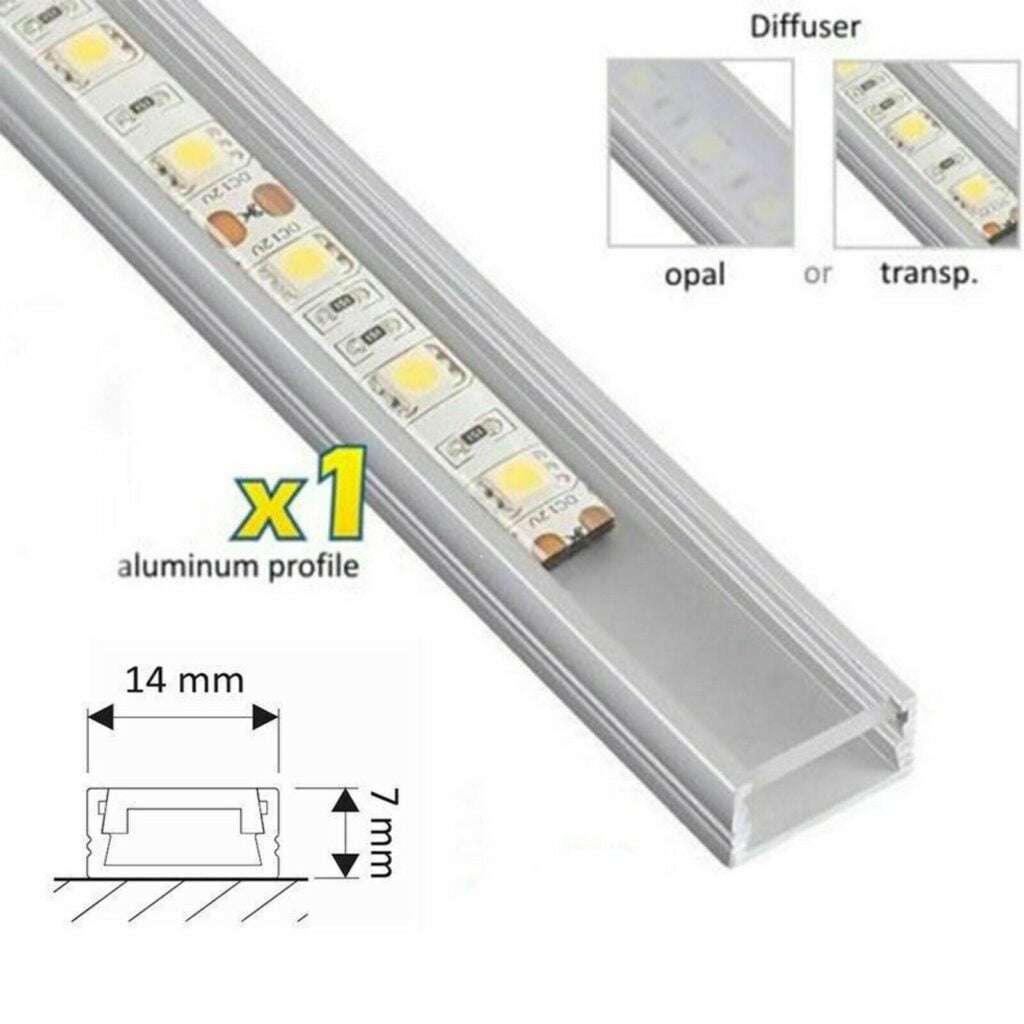
Heat Sink (Aluminum Extrusion)
This crucial component, typically made of 6063-T5 aluminum, enables the rapid dissipation of heat from the LED strip.
Diffuser
Made from either PC or PMMA, the diffuser envelops the LED strip, providing protection and light diffusion.
End Caps
These are usually plastic but occasionally aluminum. They come with or without holes, the former allowing LED strip wires to pass through.
Suspension Cable
A hanging cable is necessary during the installation of LED aluminum profiles. Typically, this cable is made from stainless steel.
Mounting Clips
Mounting clips are usually stainless steel, although some are plastic. They’re primarily used to affix surface or angle-mount aluminum channels.
Other Accessories
Additional accessories might include rotating brackets, suspension brackets, and connectors.
Why select an LED aluminum profile?
While an LED aluminum profile can enhance aesthetics, it does come with added costs. Here are several benefits of pairing it with an LED light strip:
- Enrich Lighting Effect: Like the opal diffuser, a well-chosen diffuser can distribute light evenly, eliminating lighting spots.
- Safeguard LED Strip Lights: External factors can damage exposed LED strips. Even waterproof versions may not endure outside environment. The LED track safeguards the LED tape from dust, water, and other external threats, providing a modern and stylish look.
- Improve Heat Dissipation: LED strips produce heat during operation. If not dispelled promptly, it can shorten the LED strip’s lifespan. The primary material of the LED aluminum profile is aluminum, known for its superior heat dissipation properties, thereby ensuring the LED strip operates within the standard temperature range.
- Easy to Create Different Shapes: LED aluminum profiles can be cut into L-shape, T-shapes, etc. The LED light strips can then be fitted into these profiles, creating many lighting effects.
- Simple Installation: The installation of aluminum LED profiles is straightforward and can be carried out by a single person. They can be trimmed to desired lengths, ideal for custom lighting setups, and installation doesn’t require many tools or much time. They can also provide lighting in areas where electrical connections are unavailable.
- Ease of Cleaning: The LED strip shielded by a diffuser can be cleaned without worrying about causing any damage.
Potential Applications for LED Aluminum Profiles
LED strip aluminum profiles are increasingly popular and can be utilized in various settings.
Cove lighting

Gate and entrance lighting
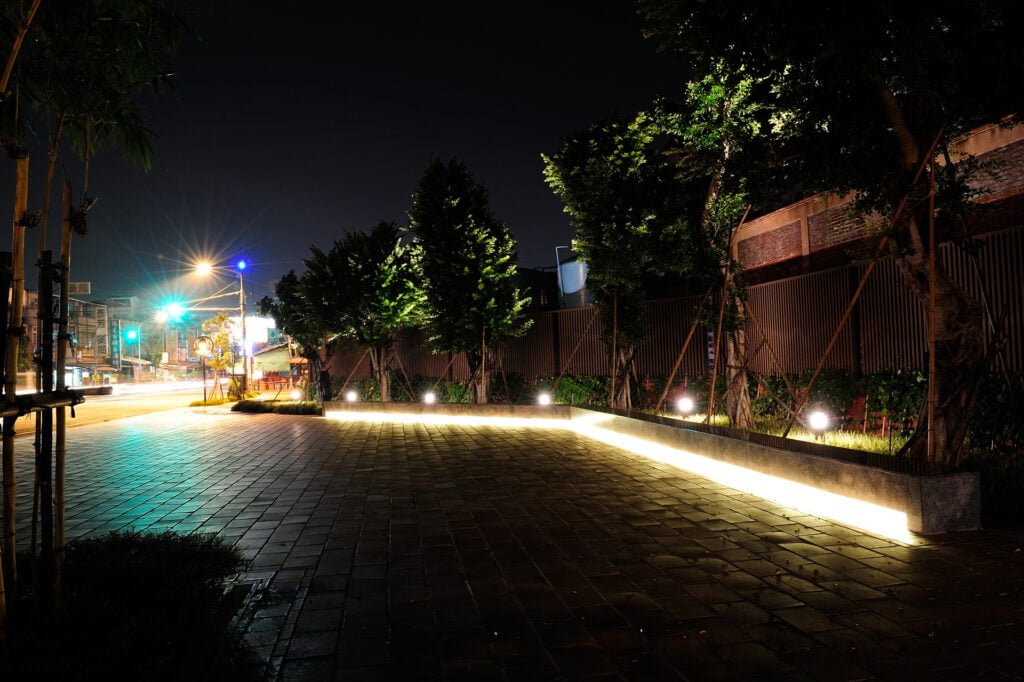
Facade lighting
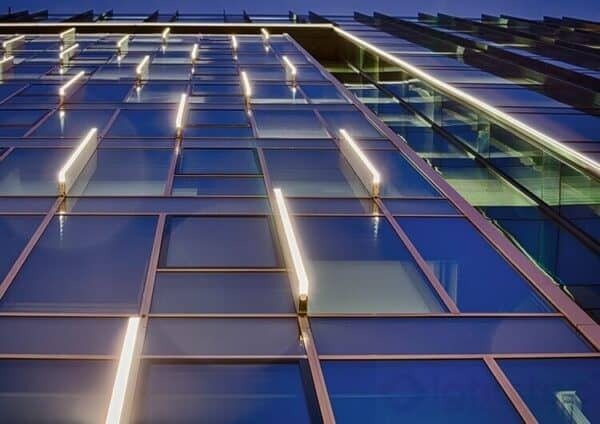
Bathroom Lighting
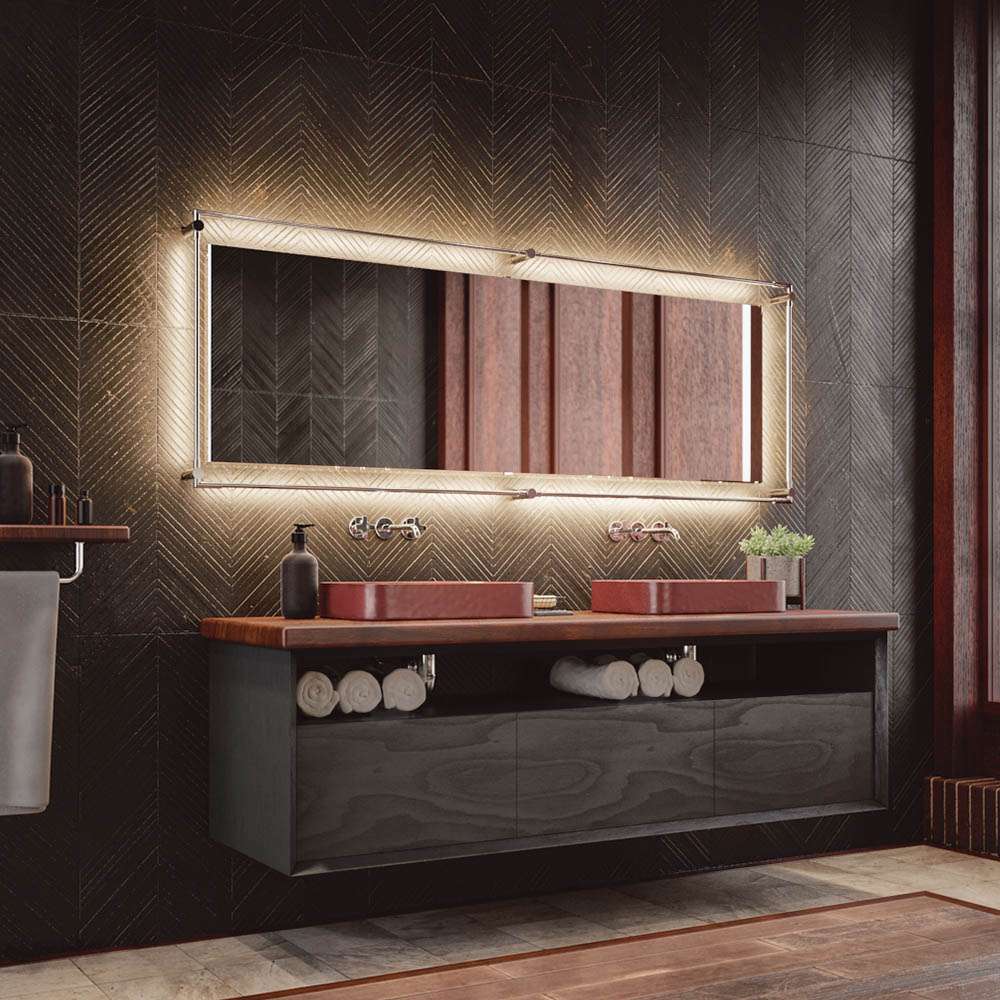
Stairs and handrails lighting
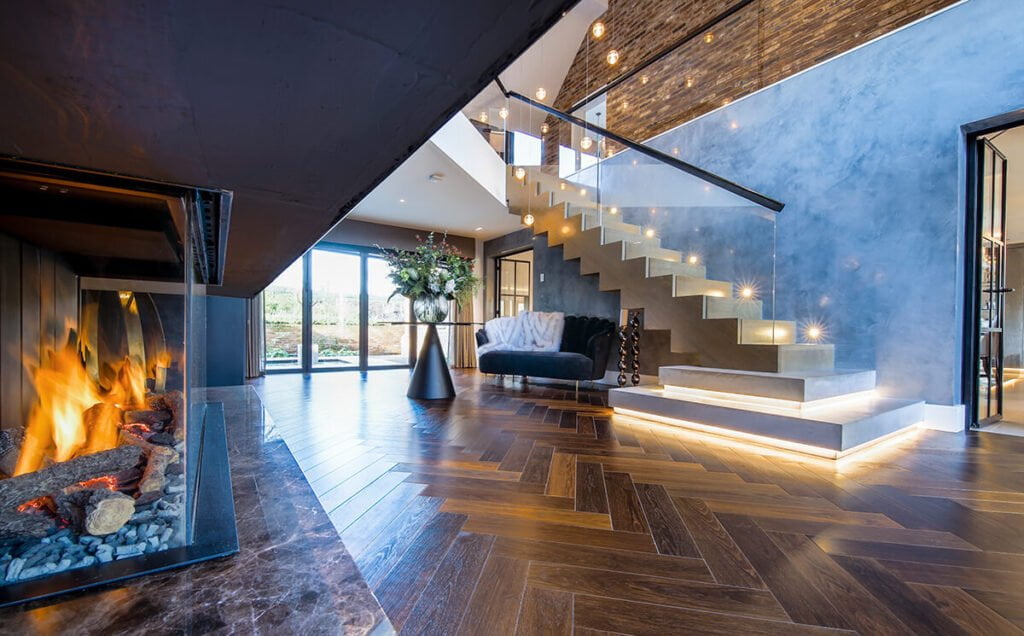
Office lighting
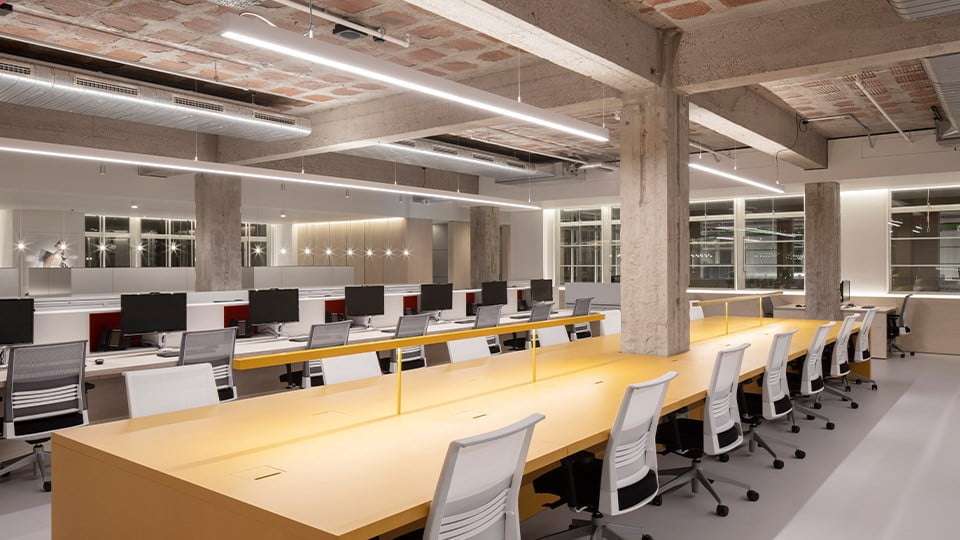
Selecting the Appropriate LED Aluminum Profile for Your LED Strip Lights: A Guide
Several vital aspects must be considered when purchasing LED aluminum profiles.
Understanding the Dimensions of LED Strip Lights
Start by confirming the LED strip’s dimensions, paying particular attention to its width. Make sure the interior width of the LED aluminum profile exceeds that of the LED strip. Then, acquire enough aluminum channels to match the length of your LED strip.
Achieving the Desired Lighting Effect
Your preferred lighting effect dictates the type of diffuser you should opt for. An opal diffuser is ideal for direct and immaculate lighting. A transparent diffuser will be your best bet if you prioritize indirect lighting with high brightness. For decorative installations, consider recessed or plaster LED channels that seamlessly blend with the surroundings for a cleaner look.
Considering the Installation Location
The location of the LED aluminum profile installation is another vital aspect to remember. For outdoor installations, choose an IP65 waterproof aluminum profile. A corner aluminum profile is perfect for corner lighting, while a recessed aluminum profile is suitable for cabinet lighting.
Choosing the Mounting Type
Lastly, think about how you’d like to mount the LED channel. Do you have a recessed area? Are your ceilings made of gypsum board? Or are you seeking the most straightforward installation process? The answers to these questions will guide you in selecting the most suitable LED channel.
Factors Influencing the Light Spot
The quality of the light spots is a primary concern for those using LED aluminum profiles. Several factors can impact the light spot in actual use.
Light Diffusion Efficiency
For diffusers like opal diffusers with a low light transmittance, they can eliminate as many light spots as possible.
Spacing between LEDs and the Diffuser
The more distant the LED is positioned from the diffuser, the less pronounced the light spot will become.
Density of LEDs
The more densely packed the LED strip’s lamp beads are, the less prominent the light spot will be.
The most recent technological advancement includes COB LED strips that utilize chips attached directly to the PCB, with a density that surpasses 500 chips per meter. Even without a diffuser, COB LED strips won’t exhibit light dots.
Guidelines for Installing LED Aluminum Profile
Installing an LED aluminum profile comprises three steps: setting up the aluminum profile, fitting the LED strip into the profile, and affixing the cover for the aluminum profile. The sequence of these steps may change based on the specific type of installation. The following sections will walk you through these installation steps in greater detail.
First Phase: Attach the LED Aluminum Profile
Due to their lightweight design, LED aluminum profiles can be easily installed. Depending on the profile’s shape and intended use, they can be surface mounted, recessed or flush-mounted, placed in a corner, or suspended. Installation is typically done using tools and accessories such as mounting brackets, screws, 3M double-sided tape, mounting adhesive, suspension cables, and fasteners.
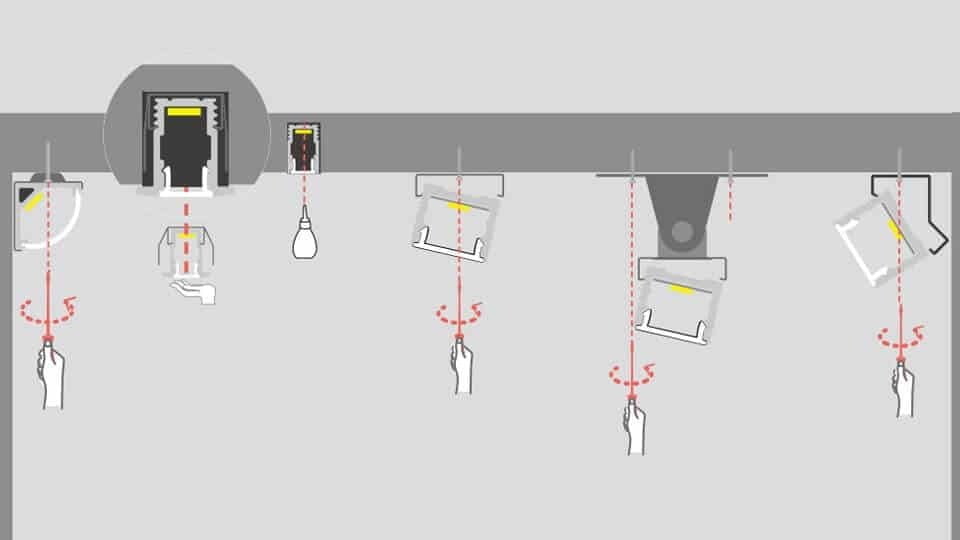
Aluminum Profile for Surface Mounting
The LED strip light channel can be attached directly to any surface, such as a wall or ceiling, via mounting brackets, 3M double-sided tape, or screws. Mounting brackets typically come with pre-drilled holes for easy installation. You can swiftly secure them onto the wall using screws and snap the aluminum profile into place.
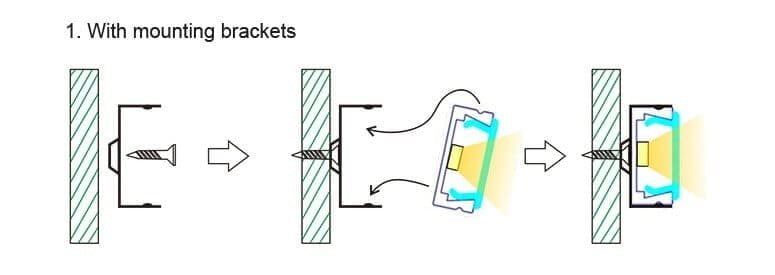
Installation of the LED strip light channel using 3M double-sided tape is straightforward. All it requires is preparing the surface by making sure it is clean and dry. Isopropyl alcohol can be used as a cleaning agent, and if the substrate is oily, acetone is a good alternative.
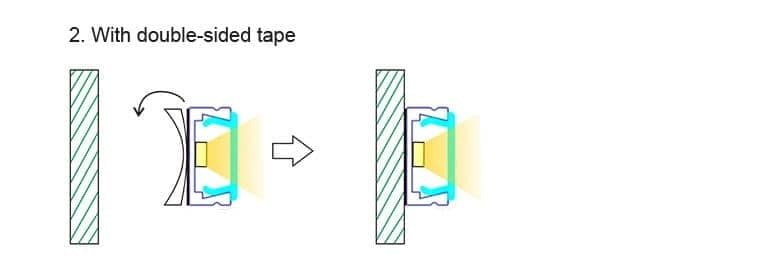
The LED profile is aluminum so that it can be easily drilled through with a screw. This feature allows the aluminum profile to be quickly affixed to the mounting surface.
Aluminum Profile for Recessed or Flush Mounting
The aluminum profile can be installed so it sits behind a wall or other surface, making the contoured opening align smoothly with the surface. To achieve this, you’ll need to create a recess in the mounting area that matches the width and depth of the LED strip channel.
Fear not if you’re concerned about the recess opening being uneven or too wide. LED aluminum channel tracks come equipped with lips (also referred to as wings or flanges) on both sides. These tips can cover any unsightly recess edges or gaps when flush-mounted.
Specific LED aluminum profiles feature two recesses in their sidewalls. You can attach mounting clips o the first or second recess to adjust the mounting height and cooling distance between the LED profile and the recess base on the mounting surface.
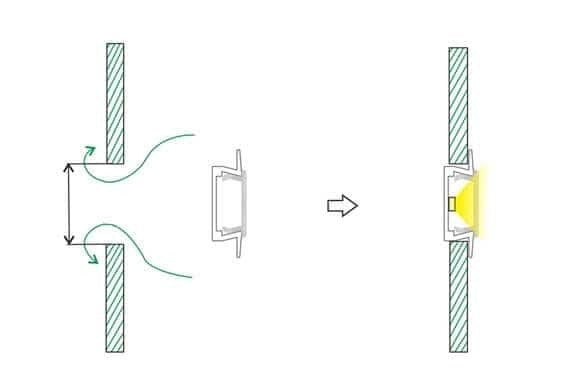
Aluminum Profile for Corner Mounting
The angular LED aluminum channel is an excellent angle mounting substrate for LED strips. It offers beam angles of 30°, 45°, and 60° relative to the mounting surface, enhancing the ambiance of a room’s corners. Corner mounting is facilitated by mounting brackets or double-sided adhesive tape.
Corner mounting of the LED aluminum channel optimally utilizes spaces that other light fixtures can’t reach. When planning lighting designs, paying particular attention to dark corners is crucial. LED profiles designed for corner mounting effortlessly illuminate corners stylishly and elegantly. To understand the superior thermal performance of corner-mounted LED profiles, consider the 45° beam angle LED profile as an example. This profile has an internal base angled at 45° relative to the profile’s two walls. This design creates a cavity between the inner base and the two walls of the LED channel, enhancing the cooling of the LED strip and the channel itself.
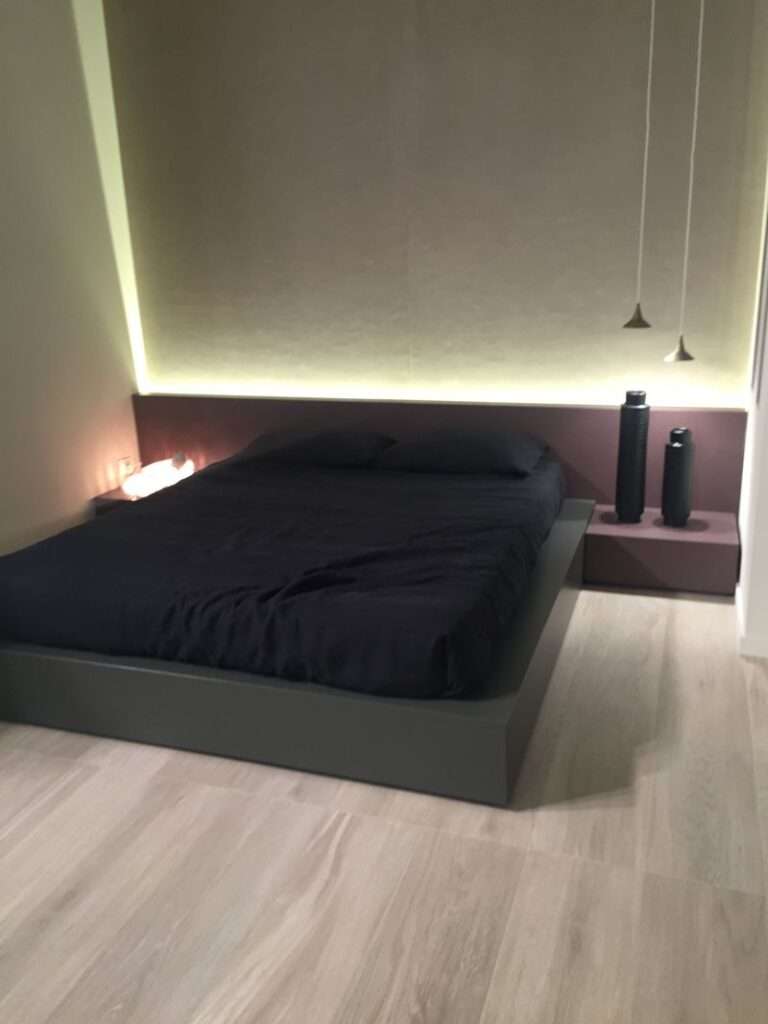
Suspended Mount LED Aluminum Extrusion Profile
LED extrusion profiles are increasingly used in sophisticated strip lighting for modern interiors. Suspending the LED extrusion profile from the ceiling introduces a fresh approach to creating modern overhead lighting. Pendant cables, buckles, and fasteners are typically employed to suspend these LED profiles.

Second Phase: Install the LED strip lights into the LED extrusion profile.
Follow a typical peel-and-stick installation procedure. Remove the protective liner from the 3M double-sided tape and affix the LED strip to the inner base of the aluminum channel.
Third Phase: Connect the LED aluminum channel with its cover.
Begin by aligning the cover with the LED aluminum channel at one end, then press the cover into the retaining grooves on the channel’s inner walls. Press until the other end clicks into place; the click indicates a secure fit.

LED aluminum profile vs. COB LED strips
Both COB LED strips, and LED aluminum profiles are viable options in LED linear lighting design. They each provide spot-free lighting, but what distinguishes them?
COB LED strips to create a linear lighting effect thanks to their high-density chips, eliminating the need for additional diffusers. These strips can be mounted with adhesive and come in waterproof and non-waterproof versions for indoor and outdoor use.
Conversely, aluminum profiles serve as an accessory to LED strips. They offer protection for the LED strip and aid in quick heat dissipation.
While aluminum profiles are rigid and difficult to bend, COB strips are flexible and easily bent.
The IP20 non-waterproof COB strip is exposed to the air on the PCB board, making it susceptible to the conditions of its installation environment. Overheating can reduce the lifespan of the COB strip significantly. However, using an aluminum channel LED strip light dissipates heat and results in a more appealing installation effect.
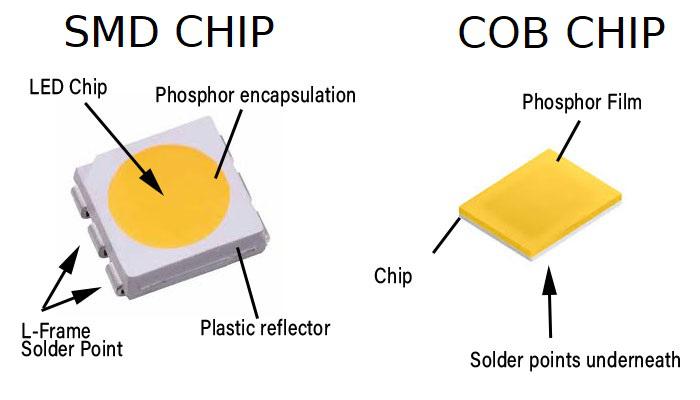
LED aluminum profile vs. LED neon flex
LED neon flex lights and aluminum profiles can achieve a spotless light effect. However, neon lights are more flexible, bendable, and IP67-rated, making them commonly used for outdoor decorative lighting.
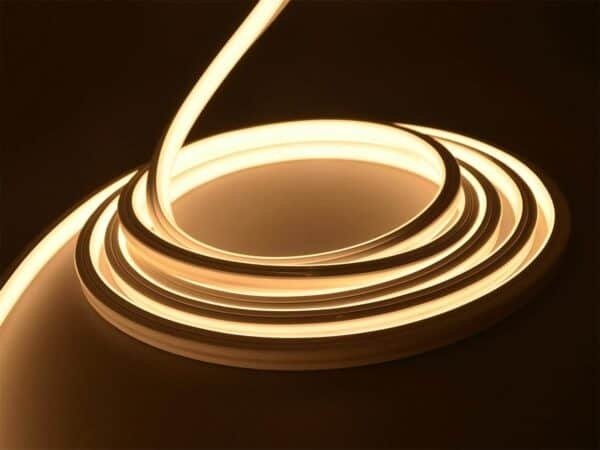
Understanding the Aluminum Profile Extrusion Process
Aluminum extrusion is increasingly prevalent in product design and manufacturing. Let’s delve into what aluminum extrusion is, its benefits, and the steps involved in the process.
What is Aluminum Extrusion?
Aluminum extrusion occurs when an aluminum alloy is forced through a die with a specific cross-sectional profile. A robust ram pushes the aluminum through the die, emerging in the shape of the die’s profile, and is pulled out along a runout table. The process is straightforward: the force applied is comparable to squeezing a tube of toothpaste.
The Aluminum Extrusion Process in 10 Steps
Let’s break down the extrusion process into ten steps.
Step One: Prepare the Extrusion Die and Move it to the Extrusion Press
Initially, a round-shaped die is made from H13 steel. If one is already available, it’s retrieved from storage. The die must be preheated to 450-500 degrees Celsius to optimize its lifespan and ensure even metal flow. After preheating, the die is loaded into the extrusion press.
Step Two: Preheat an Aluminum Billet Before Extrusion
An aluminum alloy billet, a solid cylindrical block, is cut from a more extensive alloy material log and preheated to 400-500 degrees Celsius. This makes it pliable enough for extrusion without becoming molten.
Step Three: Transfer the Billet to the Extrusion Press
Following preheating, the billet is mechanically transferred to the extrusion press. A lubricant is applied to prevent the billet and ram from sticking together.
Step Four: Push the Billet Material into the Container
The hydraulic ram applies up to 15,000 tons of pressure to the malleable billet in the extrusion press. The billet material fills the container as pressure is applied.
Step Five: The Material Extrudes Through the Die
With continual pressure, the aluminum material is pressed against the extrusion die, leaving it with no option but to emerge through the die’s opening(s), forming a fully-shaped profile.
Step Six: Guide Extrusions Along the Runout Table and Quench Them
The extrusion is caught by a puller after emerging, guiding it along the runout table at a pace consistent with its press exit. During this process, the profile is “quenched” or cooled uniformly by a water bath or fans above the table.
Step Seven: Shear Extrusions to Table Length
Once the extrusion reaches its full table length, a hot saw separates it from the ongoing extrusion process. Temperature regulation is crucial at each step. Despite the quenching post-extrusion, the profile is not entirely cooled yet.
Step Eight: Cool Extrusions to Room Temperature
The table-length extrusions are then mechanically transferred from the runout table to a cooling table. They remain there until they cool down to room temperature. After cooling, they are ready for the stretching process.
Step Nine: Move Extrusions to the Stretcher and Align Them
The profiles undergo some natural twisting that needs correction. To do this, they are taken to a stretcher. Each profile is mechanically gripped on both ends and pulled until it straightens and falls within the specified range.
Step Ten: Move Extrusions to the Finish Saw and Cut Them to Length
The straightened, hardened table-length extrusions are transferred to the saw table. They are cut to predetermined lengths, typically between 8 and 21 feet. At this stage, the extrusions have properties that match the T4 temper. After sawing, they can be placed in an oven to age to the T5 or T6 temper.
The following outlines the process post-extrusion, which includes heat treatment, finishing, and fabrication.
After extrusion, profiles undergo a heat treatment procedure to amplify their properties. Subsequently, these profiles get surface finishes for aesthetic enhancement and improved corrosion resistance. To attain their final dimensions, they also undergo various fabrication procedures.
Heat Treatment: Augmenting the Mechanical Qualities
Heat treatment can be applied to alloys in 2000, 6000, and 7000 series to improve their ultimate tensile strength and yield stress. This involves placing profiles in ovens to speed up the aging process, achieving T5 or T6 tempers. For example, untreated 6061 aluminum (T4) displays a tensile strength of 241 MPa (35000 psi), while the heat-treated version (T6) has a tensile strength of 310 MPa (45000 psi). Customers need to know their project’s strength requirements to ensure they choose the correct alloy and temper. Post-heat treatment, profiles can undergo finishing procedures.
Surface Finishing: Beautification and Enhanced Corrosion Resistance
Aluminum profiles can experience various finishing operations, enhancing their visual appeal and corrosion resistance. There are additional benefits too. For instance, anodization expands the metal’s natural oxide layer, thus augmenting its resistance to wear and corrosion, boosting surface emissivity, and incorporating various colored dyes. Other processes like painting, powder coating, sandblasting, and sublimation (to create a wooden appearance) can also be performed. Multiple fabrication options for extrusions are also available.
Fabrication: Achieving the Desired Final Measurements
Fabrication processes enable attaining the desired final dimensions of your extrusions. Per your specifications, profiles can be manipulated – punched, drilled, machined, cut, etc. Whether the fins on an extruded aluminum heatsink must be cross-machined to create a pin design or drill holes into a structural piece, a broad array of operations can be carried out on aluminum profiles to ensure a perfect fit for your project.
Process of Plastic Cover Extrusion:
Plastic extrusion is a mass-manufacturing process where raw plastic is melted and formed into a continuous profile. Products such as pipe/tubing, weatherstripping, fencing, deck railings, window frames, plastic films and sheeting, thermoplastic coatings, and wire insulation are made using this process. It begins by feeding plastic material from a hopper into the extruder’s barrel, which melts gradually due to mechanical energy generated by rotating screws and heaters aligned along the barrel. The molten polymer then gets shaped via a die and hardens upon cooling.
Why Select MyLikeLed Aluminum Profiles?
MyLikeLed, a professional manufacturing factory, has been specializing in LED aluminum profile production for over a decade. We provide a wide range of high-quality products, including LED aluminum profiles and LED strips, produced by rigorous quality standards.
- 200+ LED Aluminum Extrusions: MyLikeLed offers over 200 popular LED aluminum profiles. Thus, you can find the perfect aluminum channels for your lighting project.
- Prompt Delivery: We can deliver most orders within 3-5 days with a large inventory of LED aluminum profiles. Some unique styles not in stock can be delivered in about 12 days.
- Customized Service: We offer customized services for specific lighting projects that cannot be met with our existing LED aluminum profiles. Just share your idea with us, and we’ll bring it to fruition promptly.
- Technical Assistance: We offer professional, timely pre and post-sales services. Our skilled technical team is committed to answering.
Conclusion
The array of advantages LED aluminum profiles offer to establish them as an ideal choice for diverse lighting uses. When deciding on a purchase, always consider your project’s unique requirements and opt for an LED aluminum profile that’s ideally suited for the task. This product will deliver excellent performance and enduring results, owing to its numerous benefits.
MyLikeLed is a prominent manufacturer, factory, and provider of led aluminum profiles based in China. We cater to the demand for popular led aluminum profiles, led strip aluminum profiles, led aluminum channels, led aluminum extrusions, led diffusers, and led aluminum heat sinks, all of which provide high efficiency at an affordable price. Our led aluminum profiles are CE and RoHS-certified, guaranteeing superior performance and longevity. We also cater to customized solutions, OEM, and ODM services. Bulk orders are welcomed from wholesalers, distributors, dealers, traders, and agents.
In addition to our aluminum profiles, MyLikeLed produces top-tier LED strips and LED neon flex. Our products undergo stringent testing in our advanced laboratories to ensure they meet the highest quality standards. Moreover, we offer personalization options on our LED strips and neon flex. So, if you are searching for premium LED strips and LED neon flex, get in touch with MyLikeLed without delay!
FAQs
You should use an aluminum profile because it protects the LED strip from dust and damage, enhances heat management, and creates a more professional, polished lighting effect.
Aluminum profiles are not absolutely necessary, but they are highly recommended. They help your LED strips last longer, look better, and perform more efficiently.
Yes, aluminum profiles can easily be cut to custom lengths. Most profiles can be trimmed with a standard saw to fit your specific project needs.
Yes, most aluminum profiles include a cover or diffuser. These covers help soften and spread the light evenly while protecting the LED strips from dust and moisture.
You can install aluminum profiles almost anywhere—under cabinets, along staircases, on walls, ceilings, shelves, or even outdoors with waterproof options.

Hi, I’m Xylia Xiong, a sales professional with 14 years of experience in the LED strip light industry. I specialize in providing tailored solutions, leveraging my expertise in LED products and the latest industry trends. Known for effective communication and problem-solving, I’m dedicated to helping lighting manufacturers, importers, and distributors achieve their goals.
Let’s work together to create customized solutions that exceed expectations.
Related Posts

The Best LED Strip Lights You Can Buy Right Now

Comparing WS2811 Vs WS2812B: Key Differences


